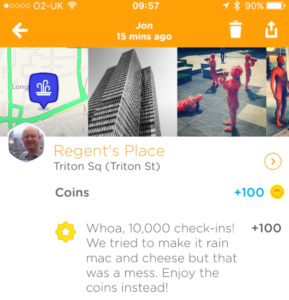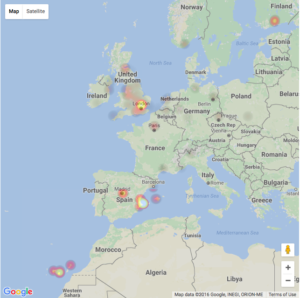Lots of publishers I have spoken to get a little confused when their ad impressions counts are different to their page impressions. So my goal here is to try and identify the common reasons for the differences. The fact that advertising systems counts ads not pages is the first key difference.
The other day, I wrote, what I thought was, a handy guide to the basic web measurement concepts of page impression, visit and unique user metrics. Haven’t read it? Please do so before reading this one.
Back? This time I’m going to talk about a new impression metric that is often confused with the measurements I spoke about last time: the ad impression. To those of us in the digital advertising tech business the ad impression is our measure of scale and value for a website. However, our measurement counts advertisements and not most of those other things that I talked about last time.
How do they differ then?
Last time I noted that a page impression was counted every time somebody viewed a page of web content. That page, however, may have three or four (and often, many more) advertisements on it. Our industry, therefore, counts the number of times advertisements are shown. So, one page impression may be one ad impression but it may also be three ad impressions depending on the number of advertisement spaces a publisher has built into their pages. It’s important not to confuse them as these impressions are very different.
Lots of publishers I have spoken to get a little confused when their ad impressions counts are different to their page impressions. So my goal here is to try and identify the common reasons for the differences. The fact that advertising systems count ads not pages is the first key difference.
Secondly, the advertising system will only count an advertisement impression when it is asked, by the browser, for the ad. It is not inconceivable that the advertisement system may not get the request for the ad and, therefore not count it (if the ad system is broken, or if it is slow, then the user may not wait around for the ad). Result: the page impression is counted but not the ad impression(s).
Thirdly, advertising systems try not to count robots, spiders and other automated web systems that make the web work for us but do not represent a human actually looking at an advertisement. After all, a computer is not really in a position to buy a new car. I noted last time that when counting page impressions then those things should not be counted either. However, if the system measuring your pages is configured with a different list of what is – and what is not – a web robot then some pages may be counted when the advertising system might not count – or vice versa. Ideally, vendors of both systems would be using the same list but, sometimes and for many different reasons, they can’t. So the result is that a page counting system may not quite be counting the same people that an advertising system may be counting. The main thing here is that this is OK. The systems have different counts because they look at different things. You know sometimes there are apples and sometimes oranges.
The next reason for the difference is simply to do with the way websites are set up. Many sites do not put advertisements on every page on their site. It may sound obvious but, if there is no advertisement placed in the page, it’s never going to count as an ad impression I once spent a day trawling through the data for a very large, well-staffed, UK website to help explain differences in page and ad impression counts and I discovered hundreds of pages that contained no ads. The site had sprawled and their site management systems were simply not inserting all the right codes. The clever coders and designers who build websites sometimes miss this. There’s a whole other post about how, if your site is ad-funded, advertising should be part of the design process – but I digress.
Ask your web development team to look at all the places where there are advertisements on your site but they don’t call the ad-server to deliver them. This is often referred to as ‘hard coding’ because the advertisement code is hard-wired directly into the web page rather than designed to ask the ad-server to select an ad. This is a very common cause of differences between website page counts and ad impression counts. It’s often done because the ‘hard wired’ ad will be around for a long time the publisher does not want to pay the ad-serving company to continually select exactly the same advertising copy in exactly the same space. But, as with our examples above, if the ad-server is not asked to select the advertisement it can’t do its job and count it.
It’s worth pointing out that sometimes the ad-server appears to be asked for lots of advertisements and, even when accounting for multiple ads on a single page, the number looks too high. Here it’s worth checking that the ad-server code is correct on the page. Because ad-server code tries to do clever things to account for the many ways in which people view your site (with multiple browsers that support different standards) then incorrectly formatted code may ask for several advertisements when only one is displayed. The result is too high counts because the ad-server is unable to determine exactly which one will be displayed so assumes they are all valid. This is one for your coding team.
Also in the ‘too many ads counted’ category is the fact that you must be comparing the same site boundaries. Is your ad technology serving advertisements into other places? If it is, then we must ask if the code on those ‘other’ places is correct or is telling the ad-server that the request is coming from somewhere else. Most ad-servers rely on the code on the page, the ad-request, to know where the ad is being delivered to. If your request is telling the system it should be selecting an advertisement for Site A but it is, in reality, Site B then the ad system may assign the count to the wrong site (worse, it will also select an advertisement that may not really be valid for Site B). Is the right code in the right place?
Finally, there are a couple of other reasons that add to the differences. Some people actively block advertisements using special software in their browser. If they do then the advertising system won’t count them. Some ad systems also try to track suspicious behaviour (such as people clicking lots of times on advertisements trying to inflate the click-rate to make the site look better or generate additional revenue). If such browsers are detected then they are often blocked and removed from the advertising counts while they may not be removed from the page counts. Again, it’s valid because we’re looking at website traffic and audiences from different perspectives.
You also need to take into account the time is takes the advertisement to be served. Advertisers generally prefer that ads are counted when the entire piece of copy or creative is delivered. If it’s one of those rich, interactive, animations it could be taking longer than you imagine for all the file to be delivered. If the count happens once all content is delivered to the user’s browser then your ad-system may not be counting the ad for a short period after the ad looks like it’s been shown. This is one to check with your ad-server technology vendor. When do they initiate the count?
Thus, your web analytics and your ad-impression counts may differ for valid reasons. The key is to ensure that, if you rely on advertising to fund your endeavours, you’re giving your advertising system the best change of showing an advertisement in all the places you want them to appear. Make sure your content control systems are inserting the right codes in all the right places.
In summary, if you’re doing all the checks and you’re content systems are inserting the right codes then your advertising system is doing the best job it can to count the advertisements for you. If it gives you a different number then you shouldn’t worry too much – there’s an acceptable difference that you can work with.
Update: it’s taken me over two years to write one of the pieces I suggest above: the one about if advertising is central to your offering then you need to think about it in the design process. Read Get Your Product Right Or Get In The Liferaft for some insights there.


